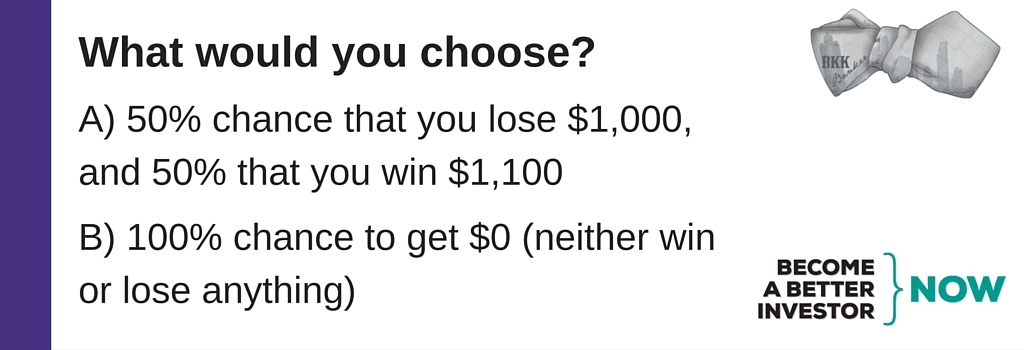Warren Buffett Knows How to Deal with Painful Losses | Loss Aversion
How to recognize loss aversion
Remember that stock which you bought that went down by 30%, and you didn’t sell? If you are absolutely convinced that a stock will do well, but then the price falls by 30%, it’s easy to think: “It’s on sale! I’ll invest more” to avoid or delay the loss.
Let’s do a test from my previous post How Rational Are YOU?
Choose between A or B and if I contact you tomorrow to ask you to honor your bets, you’ll have to do it. 😉
So, Option A has an expected value of $50 and B has an expected value of $0. If you are like most people (sorry we’re usually not as unique as we like to think, so I assume you are), you chose option B. Which completely contradicts the rationality set out in expected utility theory (EUT).
What is loss aversion?
One of the reasons you may avoid selling a stock that is down 30% and that you would always choose Option B over A is that losses are painful, they’re more painful than an equal gain makes you feel good. Studies on loss aversion, starting with Kahneman and Tversky’s seminal paper in 1979, have found that you feel a loss 2-2.5 times stronger than an equal gain. This makes you try to avoid more losses, i.e. you are loss averse.
Why is loss aversion a problem?
You take on more risk to avoid sure losses. You keep that stock when it’s down 30% just because you don’t want to realize your loss. If you also follow your instinct that the stock is now on sale after a 30% drop, you may be taking on even more risk. Studies on loss aversion have shown that we’re risk averse when it comes to gains, but risk-seeking when it comes to losses.
For someone new to the stock market that has heard about stocks and stock market crashes, they might also make the choice to park all their money in savings accounts, not investing at all just to avoid all potential loss. Hence, completely trying to avoid any risk at all just because of the fear of losing.
How to deal with loss aversion
If you have always kept all your money in a savings account until now, you might want to consider investing at least some of it. If you choose to invest in the stock market, unfortunately, you’ll need to bear some risk to get the potential of gaining a return.
If you’re already in stocks, just admit to yourself that you can’t always win. Zero-based thinking can help you, e.g. What if you didn’t own that stock before it fell by 30%, would you buy it now?
Warren Buffett has worked out how to avoid the pain of losses: “Rule #1: Never lose money; Rule #2: Never forget Rule #1.” 😉
Stop-loss is a powerful risk management tool. It won’t ensure you never lose money, but the benefit of implementing a stop-loss is that you predetermine your future action and are not making decisions in an emotional state. Like when that 30% loss feels more like a 60-75% loss. Stop-loss helps to preserve capital and protects you from your own emotions.
Read more books of the Behavioral Bias Bible
DISCLAIMER: This content is for information purposes only. It is not intended to be investment advice. Readers should not consider statements made by the author(s) as formal recommendations and should consult their financial advisor before making any investment decisions. While the information provided is believed to be accurate, it may include errors or inaccuracies. The author(s) cannot be held liable for any actions taken as a result of reading this article.


